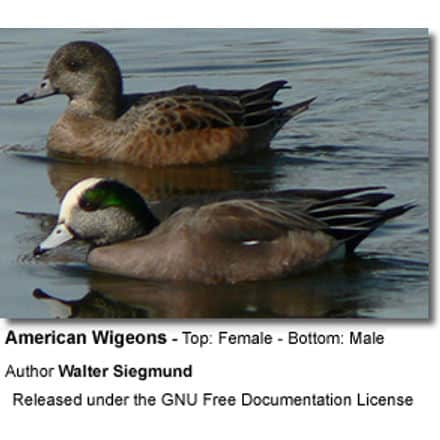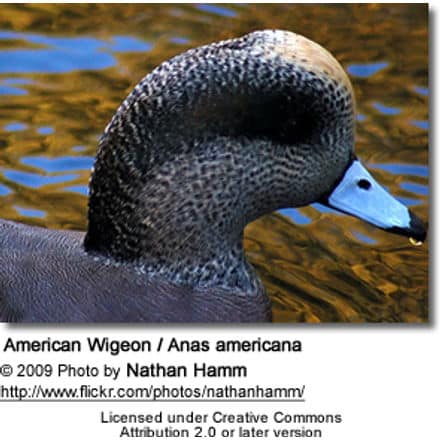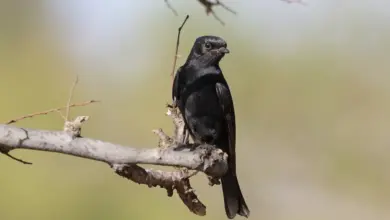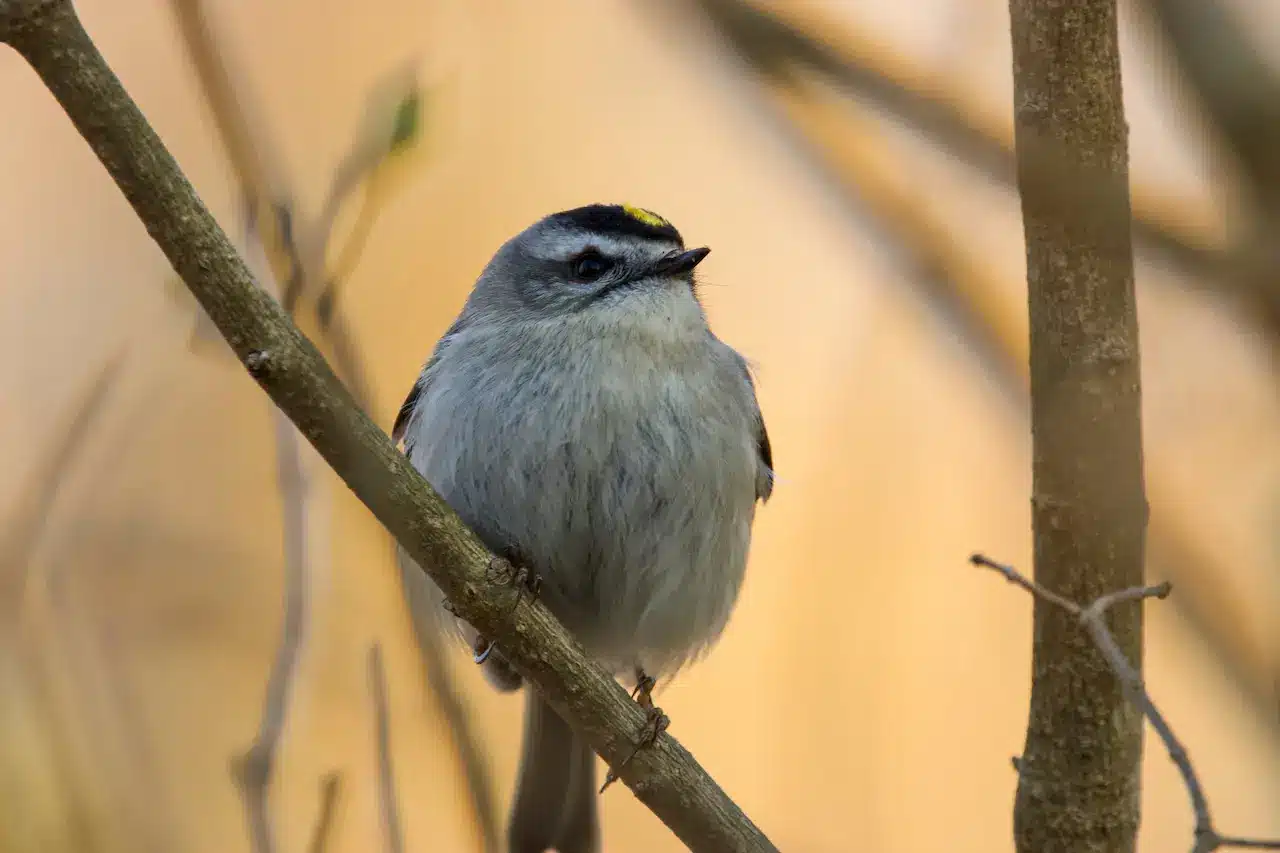American Widgeon or Baldpate
The American Wigeons or American Widgeon (Anas americana) are also known as Baldpates, named so for the cream-colored cap running from the crown of its head to the bill (pate is another word for head).
While foraging on the water with other birds, they are known to steal pieces of vegetation brought to the surface by other water birds. For this reason, they are sometimes referred to as “robber” or “poacher” ducks.
These common and widespread dabbling ducks are found in North America south to northern South America.
Outside the breeding season, they are highly gregarious and typically occur in small mixed flocks. They may form large flocks during the migration or at favored feeding sites. This species can be distinguished from other dabbling ducks by its small bill and the male’s white forehead.
They are most commonly observed swimming and feeding, and are, in general, most active on the water.
During the breeding season, however, they aggressively defend their breeding territories, which tend to be spaced out, with only one pair in a pond.

Distribution / Range

American Wigeons breed in northwestern North America and occur throughout the continent during the migration and in winter. They mostly breed in northwestern to central North America as far north as Alaska and the Northwest Territories in northern Canada; and as far south as northeastern California and northern Colorado.
These strongly migratory ducks migrate south to winter along both the Atlantic and Pacific coasts of North America, and along the Gulf of Mexico; extending south through Mexico and Central America, to the northern parts of South America; as well as the Bermuda Islands and Hawaii. Their wintering range includes all 48 lower USA states.
They are rare but regular vagrants to Western Europe (Britain), as far as northeastern Siberia and Japan.
In the winter, they are found most often near freshwater lakes, rivers, marshes, and sheltered estuaries and bays, with abundant plants for feeding.
Description:
American Wigeons weigh between 1.13 – 2.9 lbs (512 – 1330 g); and measure between 18 – 23 inches (45 – 58 cm). The wingspan is between 30 – 36 inches (76 – 91 cm).
This medium-sized duck is larger than a teal but smaller than a pintail. It has a round head, a short neck, and a short, pale blue or greyish bill with a black tip, and dark grey legs and feet. The body is reddish-brown, with dark iridescent-green wing patches and white markings on the forewing. The belly is bright white.
This wigeon undergoes two adult molts per year – in the spring it molts into breeding (alternate) plumage and in late autumn into the non-breeding (eclipse) plumage. Juveniles molt in the first year.
Adult Male Description
Breeding (or Alternate) Plumage: The forehead and forecrown are either white or cream-colored. The cheeks and chin are greyish. The rest of the neck, face, and upper back are buffy white with heavy black speckling. A broad dark-green patch extends from behind the eyes to the nape (back of a bird’s neck). His undertail coverts (feathers) are black. The bill is blue-grey with a black tip. In flight, the males can be identified by the large white shoulder patch on each wing.
Non-breeding (Eclipse or Basic) Plumage: The drake looks more like the female; with variable amounts of white and green on the head and slightly brighter sides and flanks. The undertail coverts (feathers) are variably black, with some white.
Adult Female Description
The plumage is primarily grey and brown (similar to that of a female mallard); except for the greyish head, brownish-black crown with white and dusky streaks. The white wing patches are poorly defined.
Immature Description
Juvenile birds resemble the adult female.
Similar Species
- Resembles most the Eurasian Widgeon – which is only rarely found in North America. The breeding male Eurasian Wigeon has a darker (rufous) head and buffy forehead. He lacks the green stripe and greyish flanks and back of the male American Widgeon. Non-breeding males, females, and young birds are difficult to distinguish – the best field mark is the color of the axillaries (feathers under the wing – the “armpit” or “wingpit” of a bird), which are finely speckled with dark grey in the Eurasian Wigeon and white in the American Wigeon.
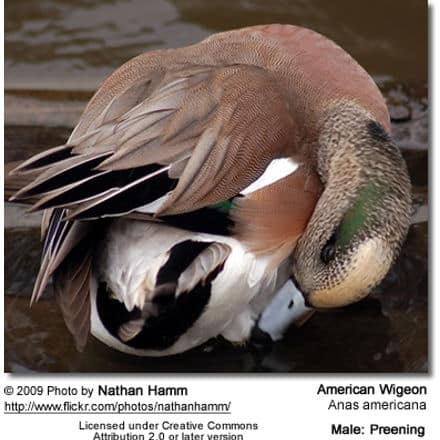
Diet / Feeding
American Wigeons are largely vegetarian consisting of the stems, roots, and leafy parts of aquatic plants, such as muskgrasses (green or grey-green colored algae) and bushy pondweed, as well as grasses and various agricultural plants.
To a lesser extent, they feed on various aquatic insects, such as damselflies and caddisflies, as well as on crustaceans, mollusks, and terrestrial insects, including beetles.
They feed both on land and water (such as shallow, freshwater wetlands, marshes, mudflats, slow-moving rivers, and ponds).
The American Wigeon’s preferred foods are leaves and roots of submerged vegetation (plants that grow beneath the surface of the water). However, since they are poor divers, these plants are often difficult for other water birds (including the larger geese) and muskrats (medium-sized semi-aquatic rodents).
In water, they feed by dabbling for plant food. “Dabbling” refers to the way they feed at the surface of the water, by “dabbling” – moving the bill around in the water while feeding, rather than by diving – as is typical of “diving ducks.” Dabbling Ducks rarely dive for food.
On dry land, they feed on pasture grasses, waste grain (winter wheat), clover, lettuce, leaves, wood, bark, stems, nuts, and fruits.
Growing juveniles require a higher percentage of protein and will consume more insects than adults.
They pluck vegetation with their strong bill and in water filter feed with the lamellae (miniature ridges inside the bills of water-feeding birds or “teeth”) on the upper bill.
Breeding / Nesting
Pairs start form at the arrival on the wintering grounds, with males performing various courtship displays to attract females, such as swimming with heads thrust forward and wings pointed upwards; or facing the females with wings pointed upwards and dipping their bills into the water.
The male may also emit high-pitched calls with his body in erect posture and stiffening his upper head feathers while standing either behind, ahead, or beside the female.
They are usually paired up by February and breeding typically takes place in spring.
The females select the nest site, which is typically placed on dry ground, yet near water, in a well-concealed location in areas of tall grasses and brush cover, in areas with ample food supplies.
The nests are constructed of grasses and weed stems (although sometimes they will nest in ground scrapes); and are lined with down and leaf litter.
A clutch may consist of 3 – 12 eggs, but mostly 6 – 10 creamy white eggs are laid.
The incubation begins after the clutch and usually continues for 23 to 25 days to hatching. The female alone incubates the eggs and she spends nearly 90% of the day in the nest.
When getting off them to feed, she covers the eggs with down and nest litter to conceal them. The male brings food to the female and spends most of his time protecting the nest or feeding. If the female senses a predator, she will silently get off the eggs and fly away from the nest to distract the predator.
If the young have already hatched, she may fly off while the ducklings dive or seek cover in surrounding vegetation. The female may perform a distraction display, feigning injury, flapping her wings over water, and vocalizing. If necessary, she may also aggressively defend the nest against intruders.
The hatchlings are covered with down and can leave the nest with the female less than 24 hours after hatching. The young initially mostly feed on insects and eventually will change their diet to mostly aquatic vegetation, picked up by dabbling and off the surface. They are fully independent when they are about 37 – 48 days old.
Pairs are monogamous and males typically remain with their mates through spring migration, nest selection, nest building, and egg laying. During the second week of incubation, males usually leave, joining other males and non-breeding females to molt.
The young reach reproductive maturity when they are about 1 year old.
Call / Song:
The American Wigeon are generally noisy. The male’s call is described as a clear whistle in three syllables: whoee-whoe-whoe, whereas the female’s is a hoarse grunt or low growl qua-ack.
Lifespan / Longevity
In the wild, American Widgeon have a maximum recorded lifespan of 21 years; however, most do not live that long. The average lifespan for a female is 1.7 years and for a male about 2.3 years (Mowbray, 1999).
As with most animals, they are most vulnerable when they are young. More than half (69%) of the great blue herons born in one year will die before they are a year old.
Repeated human disturbance close to the nesting site can also result in the abandonment of eggs or chicks.
Accidents (including roadkill), detrimental/harsh weather conditions, hunting, and predation of eggs, nestlings, and adults are typical causes of premature death.
Alternate (Global) Names
Catalan: Ànec xiulador americà … Chinese: ???, ????, ???? … Czech: Hvízdák americký … Danish: Amerikansk pibeand … Dutch: Amerikaanse Smient … Esperanto: Amerika fajfanaso … Finnish: Amerikanhaapana … Faroese: Bolladunna … French: Canard à front blanc, Canard d’Amérique, Canard jansen, Canard marèque, Canard siffleur américain, Canard siffleur d’Amériq, Canard siffleur d’Amerique, Canard siffleur d’Amérique … Irish: Rualacha Mheiriceánach … Galician: Ànec xiulador americà, Asubiador americano … German: Amerikanische Pfeifente, AmerikanischePfeifente, Amerikansiche Pfeifente, Nordamerikan, Nordamerikanisch Pfeifente, Nordamerikanische Pfeifente … Haitian Creole French: Faldam … Hebrew: ???? ??????? … Hungarian: Álarcos réce , Amerikai fütyüloréce, Amerikai fütyül?réce … Icelandic: Ljóshöfðaönd … Italian: Fischione americano … Japanese: Amerikahidori, Amerika-hidori … Lithuanian: Amerikine cyple, Amerikin? cypl? … Norwegian: Amerikablesand, Amerikansk lyngand, Blesand … Polish: Swistun amerykanski, ?wistun ameryka?ski … Portuguese: Piadeira-americana … Russian: ???????????? ??????, ?????? ???????????? … Spanish: Anade Silbón Americano, Ánade silbón americano, Anade silvon americano, Ánade silvon americano, Patito corona blanca, Pato Americano, Pato Cabeciblanco, Pato Cabecilargo, Pato Calvo, Pato Chalcuán, Pato Lavanco, Silbón Americano … Swedish: Amerikansk bläsand … Turkish: Amerika Fiyusu … Welsh: Chwiwell America
Additional Web Resources
Sound Recording … Duck Information … Index of Duck Species … Photos of the Different Duck Species for Identification


